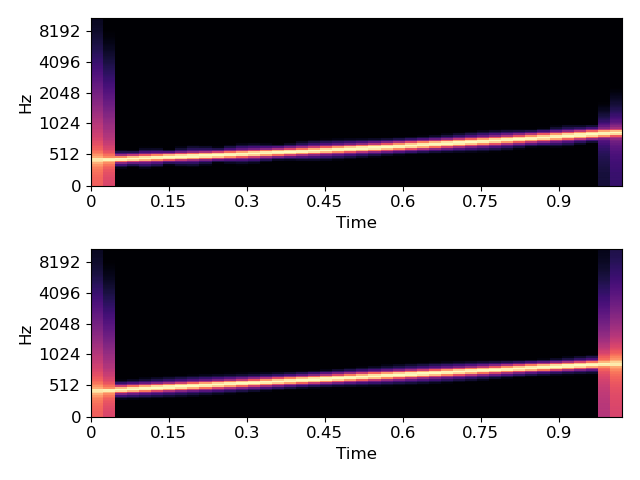Caution
You're reading an old version of this documentation. If you want up-to-date information, please have a look at 0.9.1.
librosa.core.chirp¶
- librosa.core.chirp(fmin, fmax, sr=22050, length=None, duration=None, linear=False, phi=None)[source]¶
Returns a chirp signal that goes from frequency fmin to frequency fmax
- Parameters
- fminfloat > 0
initial frequency
- fmaxfloat > 0
final frequency
- srnumber > 0
desired sampling rate of the output signal
- lengthint > 0
desired number of samples in the output signal. When both duration and length are defined, length would take priority.
- durationfloat > 0
desired duration in seconds. When both duration and length are defined, length would take priority.
- linearboolean
If True, use a linear sweep, i.e., frequency changes linearly with time
If False, use a exponential sweep.
Default is False.
- phifloat or None
phase offset, in radians. If unspecified, defaults to -np.pi * 0.5.
- Returns
- chirp_signalnp.ndarray [shape=(length,), dtype=float64]
Synthesized chirp signal
- Raises
- ParameterError
If either fmin or fmax are not provided.
If neither length nor duration are provided.
See also
Examples
>>> # Generate a exponential chirp from A4 to A5 >>> exponential_chirp = librosa.chirp(440, 880, duration=1)
>>> # Or generate the same signal using `length` >>> exponential_chirp = librosa.chirp(440, 880, sr=22050, length=22050)
>>> # Or generate a linear chirp instead >>> linear_chirp = librosa.chirp(440, 880, duration=1, linear=True)
Display spectrogram for both exponential and linear chirps
>>> import matplotlib.pyplot as plt >>> plt.figure() >>> S_exponential = librosa.feature.melspectrogram(y=exponential_chirp) >>> ax = plt.subplot(2,1,1) >>> librosa.display.specshow(librosa.power_to_db(S_exponential, ref=np.max), ... x_axis='time', y_axis='mel') >>> plt.subplot(2,1,2, sharex=ax) >>> S_linear = librosa.feature.melspectrogram(y=linear_chirp) >>> librosa.display.specshow(librosa.power_to_db(S_linear, ref=np.max), ... x_axis='time', y_axis='mel') >>> plt.tight_layout() >>> plt.show()
